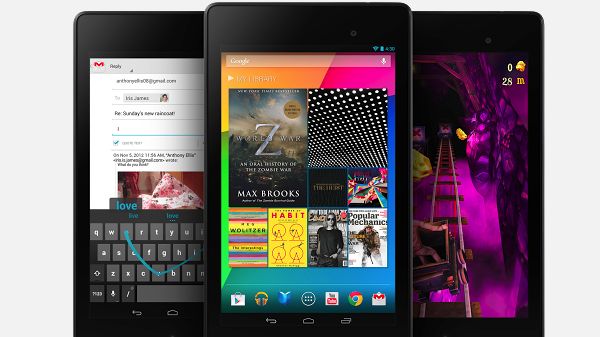TechRadar Verdict
If you're looking for a 7-inch tablet, we'll put it like this: there is no better alternative on the market. It's not quite as good as the new iPad mini, but if you don't fancy iOS this is the tablet you want.
Pros
- +
Easy to hold in one hand or two
- +
Affordably priced
- +
Durable build
- +
Fast performance
- +
Strong battery life
- +
High density display excellent for reading
Cons
- -
Comes with 6GB of space already occupied
- -
No longer the dirt cheap option
- -
Colors are slightly inaccurate
- -
No 64GB option
Why you can trust TechRadar
While everyone waited on an iPad mini with retina, Google and Asus went ahead and did one better. Presenting the new Nexus 7, an affordable 7-inch tablet with beefy specs and more pixels per inch than you can shake a 1080p jpeg at.
Whether you call it the Nexus 7 2 or just the Nexus 7, it hurdles right over the iPad mini in both parts and price. For just a little more money, it offers greater functionality than a Kindle Fire HD. It so surpasses theoriginal Nexus 7 that Google has swept last year's tablet under the rug; it seems to be retired from the Play Store altogether.
Internally, the new Nexus 7 packs a 1.5Ghz quad core processor, 2GB of RAM and comes with either 16GB or 32GB of storage. Those models go for $229/£200 and $269/£240, and there's also an LTE version selling for $300/£299. Sadly, we don't yet have official word on Australian pricing.
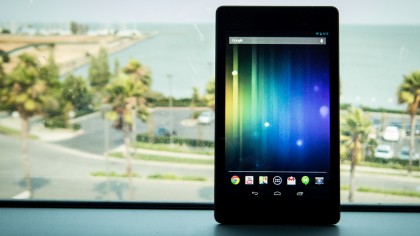
While microSD slots now feel like a relic of a bygone era, since neither Nexus nor Apple devices offer them, we have to bemoan storage space a bit here. The Android 4.3 OS found on the Nexus 7 takes up a whopping 6GB. Our 32GB tablet came out of the box with 26GB available. Those planning to go for the 16GB model need to brace for having only 10GB to play with.
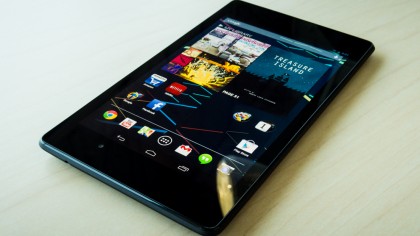
Still, no matter how you slice it, the Nexus 7 is a lot of great tablet hardware for the money, all packed in an unassuming, plastic package. That pockmarked rubber backing from the first Nexus 7 has been ditched, replaced with an all plastic black backing. It doesn't feel as slick or look as premium as the metal backing of an iPad, but it'll surely hold up against scratches better than Apple's tablet.
The new Nexus 7 is poised to change the tablet game. It has a display and a price tag that puts the iPad mini to shame, and makes us wonder what's in store for the redesigned Nexus 10.
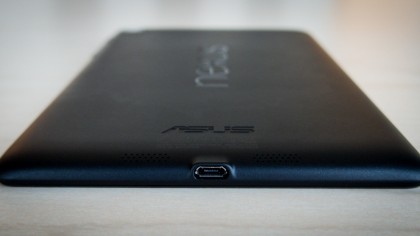
This isn't an open and shut case though. Right off the bat, if we had to register a few complaints about the Nexus 7's build, we have bring up all that bezel. Also, the industry standard of advertising the unformatted storage on a device instead of the available space needs to change, as the 16GB Nexus 7 is really a 10GB tablet.
Affordable price tags have bought the Nexus 7 some leeway, but it's no longer the dirt cheap option. Between Apple's premium iPads and Amazon's rock bottom Kindle Fire HD, is there room in the middle for a new Nexus 7?
Features and design
Start rooting for the little guy; the Nexus 7 is small, even alongside other 7-inch tablets. At 7.87 x 4.49 x 0.34-inches, it's slightly slimmer than the original Nexus 7, which measured 7.81 x 4.72 x 0.41-inches. So it's a tad a thinner, and therefore even easier to hold in one hand, something we've never felt entirely comfortable doing with the wider iPad mini.
It's not too small, but we wouldn't want it any smaller. As it is now, it's the perfect size to toss in a bag or even a coat pocket. We've always considered 7-inchers to be travel tablets and 10-inch ones to be couch companions, and the new Nexus 7 fills this role perfectly, a featherweight at just 0.64lbs (290g).
Alas, the amount of storage on the device is also lightweight. Our 32GB Nexus 7 came with 6GB already occupied by onboard software. That left us with just 26GB to play with. That's not too bad, but those eyeing up the 16GB model should be warned that they'll have just 10GB available. That, compounded with the lack of microSD slot and 64GB option, may disappoint media hounds looking to carry a large collection of movies at all times.
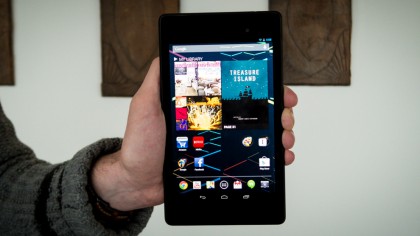
On the outside, the Nexus 7 has a durable, unassuming design; a bit dull if you want to be harsh about it. Apple fans will likely miss the premium feel of brushed aluminium, but anyone who's winced at the sight of a horribly scuffed iPad will understand opting for a tougher plastic exterior.
The Nexus 7's display is coated in standard issue Corning glass, and the rear is firm black plastic. The rubbery pockmarked backing of the original Nexus 7 has been ditched, and we're fine with that. It was a divisive design; some liked it, others didn't, and we found that the white version discolored over time.
The place where Google and Asus have really outdone Apple is in the resolution and pixel density of the screen. The Nexus 7 packs a 7-inch IPS display with a resolution of 1920 x 1200 display with 323 ppi. Compare that to the 264 ppi on a full size Retina iPad, and you can see the winner, at least on paper.
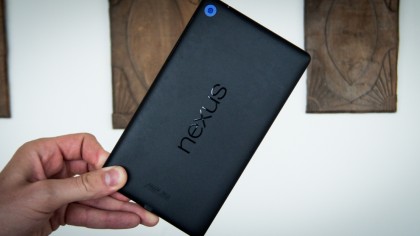
In actual real life, using fallible human eyes, you'd be hard pressed to spot a pixel on either display. They're both extremely dense, high quality displays. Compare the Nexus 7 to an iPad mini though, and it's a different story.
Apple's 7-inch offering is a mere 1024 × 768 with 163 ppi. That's by no means insulting, until you start comparing prices. With the Nexus 7 starting about $100 lower than a comparable iPad mini, it feels like high time for Apple to slap a Retina display on that thing.
The Nexus 7 has a 16:9 aspect ratio, while the iPad mini is 4:3. That gives Apple's tablet wider screen space, which is handy for the web, but films and some TV are produced in 16:9. That extra space ends up filled with black bars, like letterboxing on an old television.
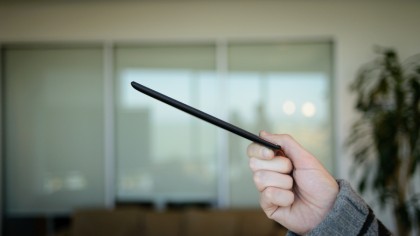
The one disadvantage of 16:9 is that it gives the Nexus 7 a ton of bezel -- unused space between the screen and the actual edge of the tablet. Because of the aspect ratio, the Nexus would need to get wider before it could get taller. That's not something we'd want, since we love how one-hand friendly this device is. It's a catch 22, and we think Google and Asus ultimately made the right call here.
The new Nexus 7 also has a very bright display display, with auto-brightness doing a perfect job of adapting to your environment. Like any tablet, it's at its best in moderate indoor light. It does washout in bright direct sunlight, but no more than the best displays out there.
It's not the best we've seen at handling colors though. They're not true to life, generally erring on the side of being slightly faded. It's really only something you can pick up on with a direct one to one comparison though.
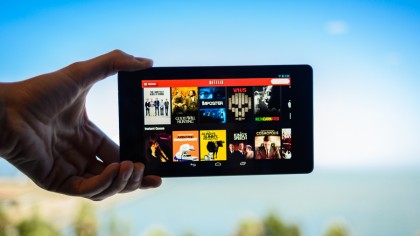
Compare a digital comic on the Nexus 7 to its print counterpart, or to a movie on quality HDTV and you can see the difference. Skin tones were a bit too light, including the Hulk from The Avengers, whose signature green pigment was shade lighter than Stan Lee would sign off on. Also, some sky blues were actually darker on the tablet than on the page.
Basically, the color accuracy is all over the map, but you'd have to be Rembrandt to really be bothered by it. For the sake of thoroughness though, it does merit a mention.
It still does fine work with video, streaming or locally stored. That 16:9 aspect is perfect for Netflix, and it's diminutive size makes it very easy to hold with one hand or two. And all that bezel space actually gives you somewhere to grip it without obscuring the screen.

It's a good movie watching device, but we were actually most impressed with the reading on the Nexus 7. That high resolution, pixel dense display is the best tablet reading experience we've had on a backlit screen.
A device without a backlight, like a Kindle Paperwhite, will always be less trying on the eyes longterm, but as far as devices without e-ink go, the new Nexus 7 is king. Text is newspaper crisp, so much so that you may end up giving yourself an accidental eye exam. On a non-mobile site, it's tempting to read tiny shrunken print rather than zoom in. Don't strain your eyes though, no matter how impressive you might find this display.
The speakers have been given an upgrade from the original Nexus 7. The tablet now sports stereo sound, thanks dual speaker grills on the rear. The grills are large, and well-placed, so they're difficult to cover with your digits when holding the tablet. We actually had trouble trying to muffle them on purpose when testing.
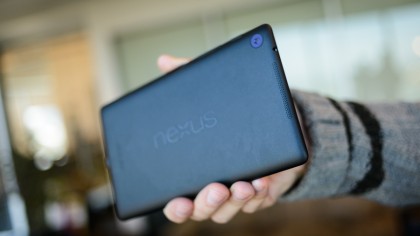
The surround sound effect is surprising for tablet speakers, and sounds don't crackle and distort when the volume is cranked all the way. Overall, the sound is a big step up from the original Nexus 7, but the speakers still aren't terribly loud. It's fine for sharing a video in a quiet or moderately noisy space, but in a crowded and loud public space, the audio will drown out. We'd recommend some headphones.
Speaking of headphones, the audio jack is found on the top right of the tablet. It's well placed by default, since you can rotate the tablet any way you like and the image will reorient itself. Therefore, if you want your cord plugging in at the top, or trailing down from the bottom, iPhone 5 style, it's your prerogative.
